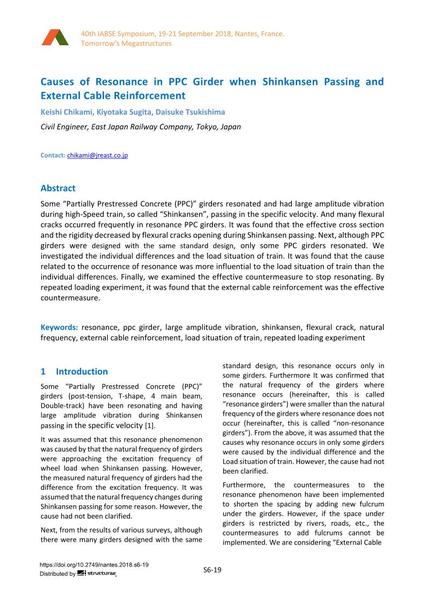Causes of Resonance in PPC Girder when Shinkansen Passing and External Cable Reinforcement

|
|
|||||||||||
Bibliographic Details
| Author(s): |
Keishi Chikami
(Civil Engineer, East Japan Railway Company, Tokyo, Japan)
Kiyotaka Sugita (Civil Engineer, East Japan Railway Company, Tokyo, Japan) Daisuke Tsukishima (Civil Engineer, East Japan Railway Company, Tokyo, Japan) |
||||
|---|---|---|---|---|---|
| Medium: | conference paper | ||||
| Language(s): | English | ||||
| Conference: | IABSE Symposium: Tomorrow’s Megastructures, Nantes, France, 19-21 September 2018 | ||||
| Published in: | IABSE Symposium Nantes 2018 | ||||
|
|||||
| Page(s): | S6-19 | ||||
| Total no. of pages: | 9 | ||||
| DOI: | 10.2749/nantes.2018.s6-19 | ||||
| Abstract: |
Some “Partially Prestressed Concrete (PPC)” girders resonated and had large amplitude vibration during high-Speed train, so called “Shinkansen”, passing in the specific velocity. And many flexural cracks occurred frequently in resonance PPC girders. It was found that the effective cross section and the rigidity decreased by flexural cracks opening during Shinkansen passing. Next, although PPC girders were designed with the same standard design, only some PPC girders resonated. We investigated the individual differences and the load situation of train. It was found that the cause related to the occurrence of resonance was more influential to the load situation of train than the individual differences. Finally, we examined the effective countermeasure to stop resonating. By repeated loading experiment, it was found that the external cable reinforcement was the effective countermeasure. |
||||
| Keywords: |
natural frequency resonance ppc girder large amplitude vibration shinkansen flexural crack external cable reinforcement load situation of train repeated loading experiment
|
||||
